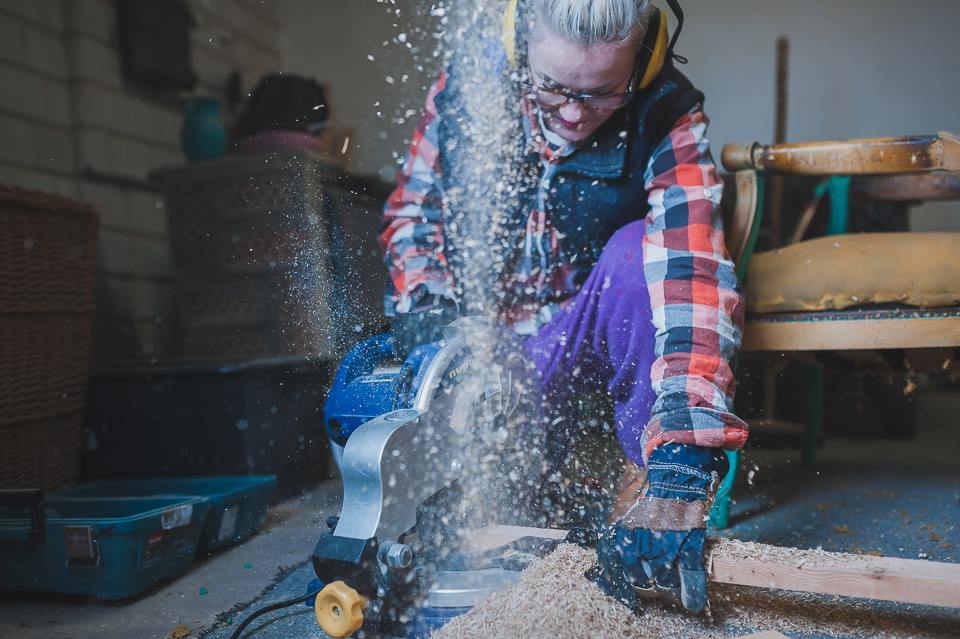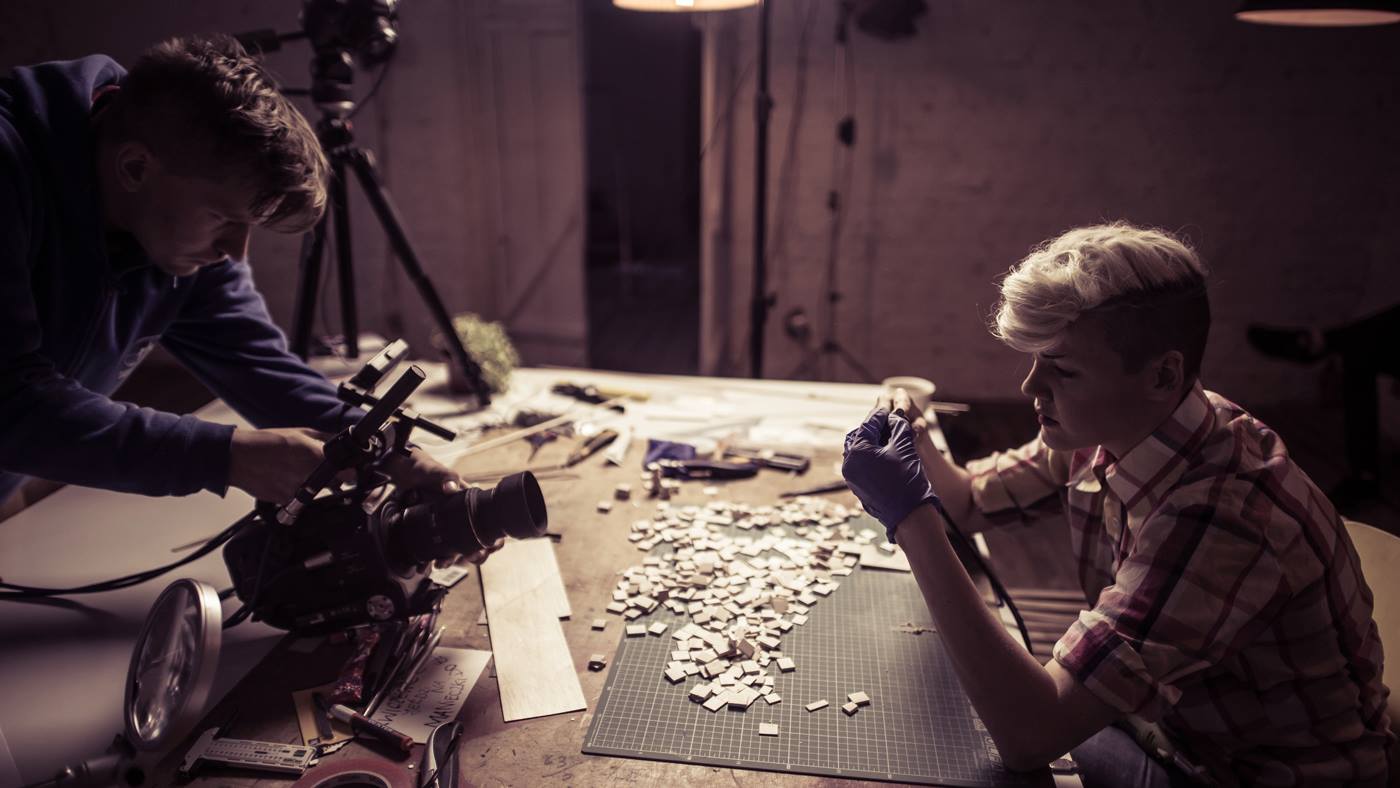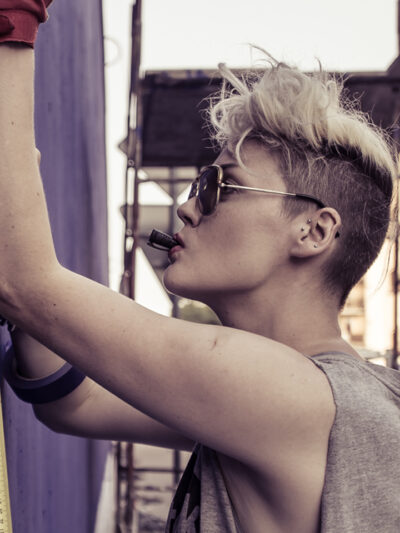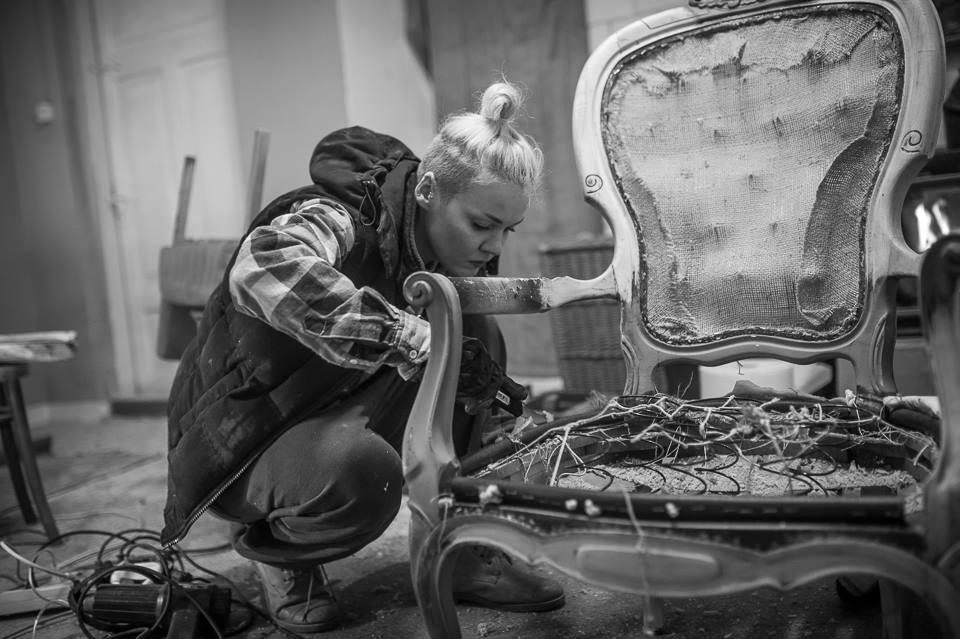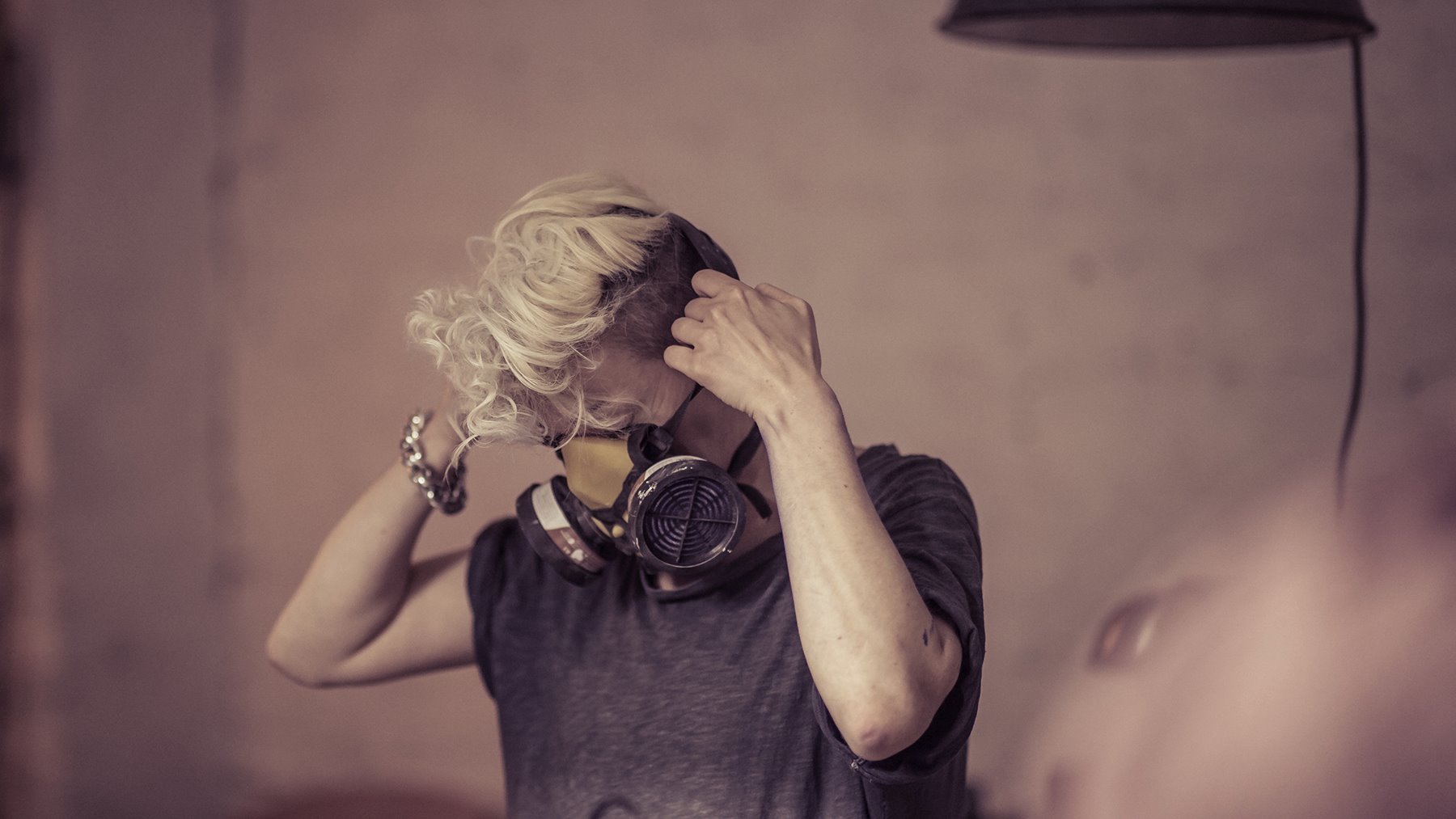Wood can be renovated many times – a conversation about ecodesign with Karolina Maksimowicz
How do the sets for the most famous music festival in Białystok designed? What is ecodesign? Why is wood irreplaceable? Are we flooded with cheap and poor-quality furnishings? And why throwing away grandma’s old furniture a bad idea?
Karolina Maksimowicz – architect and creator from the border of art and design from Podlaskie, the head designer Up to Date Festival’s visuals, co-creator of the strategy and image of the festival.
Working on Up to Date Festival gives you space for artistic expression. Which project related to the festival is your favourite?
It is difficult for me to give a clear answer to this question. The visual side of Up to Date is my child and has many aspects. For 14 years it has depended on me, the direction of my thoughts, perceptions, my creative process. My friends-and-co-creators of the festival trust me and my actions, which I appreciate very much, we consult on many aspects, but in the end, I have the free hand and I can let myself be carried away by what my creative intuition tells me.
These dozens or so years of Up to Date brought a lot of really diverse projects, both visually and thematically. Some were created in relation to broader community initiatives, some were pure visual or scenography projects. Over the years I have also co-created many projects with our festival sponsors, but they also always expected “my/Up to Date” style creation. It is difficult for me name just one project here: Whether it is ROOM ROOM installations (a monochrome room changing the interior at different editions), work on the Key Visual Festival, or designing merchandise for the Pozdro Techno De Luxe, created on the basis of second (or fifth) hand clothes. I draw a lot from each project, I also like this diversity in activities, each of them is a completely different challenge.
Many of these projects are amazing scenery – how were they inspired? Are they partly related to ecodesign?
I think the biggest inspiration for me is comes from shortages, deficits. I like to invent and create when I have certain restrictions, including financial or material ones. These activities challenge me and enhance my creativity. For as long as I can remember, the inspiration for me, e.g., in architecture, were indigenous buildings of different populations resulting from deficits, shortages, poverty. People out there had to activate their deepest layers of creativity, very often creating something from totally inadequate materials. Something out of nothing – that’s quite a trendy phrase in the recycling world right now. Another aspect that interests me and inspires me is the feeling of space by its users. I mean more precisely how a given space/object – whether it is a private/public room, scenography, architecture or sculpture, installation – affects its recipient. What emotions it evokes, how recipients feel when dealing with it, being in some space. The comfort of feeling the space has always been important to me. It was not related to the amount of goods and resources, but to the way in which this comfort was achieved, heat received, often with very small and perhaps non-standard means. I don’t know I’m clear enough, because it is a very extensive topic, I tried to put it in one bag and briefly describe it. The same goes for my installation and scenography work.
In the process of creation, the recipient is very important to me. I want to make some impressions and move some emotions; I am working on it, and I care about it. If I succeed, we are home. In the set design and actions of Up to Date, it is mainly about inviting the audience to our specific world, establishing the conditions for a certain sense of space and in it – music. Returning to ecodesign – the whole festival set designs created over the years mainly use ecodesign and recycling. I’m very much not a fan of wasting resources, buying more and more new materials, which is sometimes tempting and would certainly allow for new interesting solutions in the festival space. For years, I have been trying to build up the festival area so that installations are not just one-offs. Every year, we rework our outdoor wooden structures and sets to give people the impression of something new, but the base is always our old materials. Here, wood works best for me because it allows for all processing, grinding, renovation and painting.
What if I asked you to define what ecodesign is for you...?
For me, the most important aspect of ecodesign is to turn away from growing consumerism. People created and stood for the largest garbage dump on earth. Without thinking about the consequences, we replace things, even those that still work, we compulsively buy clothes, even if we do not need them, we renovate apartments and replace furniture because we are bored, we replace cars / bikes equipment – because better/newer versions of them appeared on the market. The old ones, even functional ones, end up as garbage. I am glad that more and more people are wondering how much, what and how they consume. I think it is important both for the environment and for the individual person. I have the impression that limiting the pursuit of objects and their possession allows for a greater focus on the things really important in life, not to mention the most important ecological aspects.
People created and stood for the largest garbage dump on earth. Without thinking about the consequences, we replace things, even those that still work, we compulsively buy clothes, even if we do not need them, we renovate apartments and replace furniture because we are bored, we replace cars / bikes equipment – because better/newer versions of them appeared on the market. The old ones, even functional ones, end up as garbage.
I like the human aspect of ecodesign. And what do you do at Przetwórnia Meblowa, Furniture Processing, what are the projects?
This project runs periodically mainly in the field of furniture restoration, creation in wood, in the form of workshops and addresses the topics of ecodesign and recycling. I’ve been “lighting it up” less frequently in recent years, but it’s still a present entity on the map. You’ll hear about new projects, including workshops, in the new year.
You mentioned working with wood. Please tell me more about it.
I love working with wood. This is something that I feel very connected to since a child. My dad used to let me play in his workshop, taught me how to use carpentry tools, and that’s why I took this passion away. Wood was always present in my life, from a young age I liked to do DIY projects, sculpt, assemble and rework. In my family home in the countryside, everything that could be done in wood, Dad did himself, manually, even though he wasn’t a carpenter by trade. From felling trees to cutting boards and processing. I’m glad I got to experience that. It taught me a lot of respect for wood material, it taught me to use even the very old pieces of wood. I don’t waste any wood; all the old boards and scrap are needed. You can create beautiful things out of them. Wood is an extremely pleasant material to process. Each piece is different, each has different qualities, each is good in its own way and for other purposes. Wood can be renovation many times, which is a very important aspect for me. Its design properties are something completely timeless in architecture.
What you said earlier suggest that we should limit the purchase of new furniture in favour of recycled furniture. Please elaborate.
We should completely limit the purchase of new furniture. Unfortunately, nowadays, in furniture production, the economic aspect plays the most important role. The largest sales are made by companies that produce the cheapest furniture, and thus – made of the least durable and not environmentally friendly materials. Just chip the of a cabinet and it’s done for. People have learned to buy furniture, which after a few years is unfortunately only suitable for garbage. They put new ones in their place. I am glad that people are starting to take an interest in the value of things. They note that, for example, the Chierowski 366 Armchair is a great design with high ergonomics, both comfortable and adapted to small spaces. Many a hipster take it is a point of honour to have such a specimen at home, and not only they. Ideally, they would renovate it themselves.
Old models of furniture were manufactured in such a way that they withstand as much use as possible and for as long as possible. These designs, e.g., in the 1960s/70s/80s, were not as numerous as they are now, but most of them were very well created by respected designers, not only in countries such as Scandinavia, where good design has been appreciated for generations, but also in Poland. Such furniture was purchased for the longest possible use. New, economy-class furniture, unfortunately, is very short-lived and problematic in disposal. There is an abundance of them on the market, and yet here the well-known reflection will be very relevant: quality, not quantity, counts.
You ran a recycling workshop. Are ordinary people with no previous experience with carpentry etc. able to salvage a wooden piece of furniture by reworking or restoring it themselves? Is it worth trying?
Yes, of course! Many people have contacted me over the years for this type of advice and I have always tried to provide. I really want people to learn how to evaluate the value of items/furniture, be able to take care of them, renovate them or convert them to their needs. Such simple renovation works are not complicated processes. I think anyone can renew such a piece of furniture with good instructions. Even without special power tools. In renovation, knowledge is important, here it is worth assessing the condition of the wood, whether it is solid wood or, for example, layered or veneered wood. Then we know with what delicacy and precision we can approach it. Another aspect is the analysis of the preparations used previously for impregnation and the assessment of what we can do with them. You can remove old layers of varnishes, polish, etc., we can also want to apply full coats of subsequent layers, reaching, for example, full colour. There are many solutions, but I think it is possible to beautifully renovate the furniture on your own, in your own home. Of course, some furniture requires a lot of time and also the above-mentioned knowledge. In such a situation, it is worth turning to someone who will perform the renovation professionally, so that we will be sure that the furniture will survive the next decades.
One thing is obvious to me: time spent on preserving an old valuable piece of furniture is worth it. As an architect, I appreciate the timelessness of furniture and its history.
Thank you very much for the interview!
Thank you!
Karolina Maksimowicz – Architect, creator of art and design from Podlaskie. She is the main designer of the visuals of Up-to-Date Festival, co-creator of the strategy and image of the festival. Karolina creates stage design/scenography, designs, and performs artistic and promotional installations, is responsible for creating clothes related to the upcycling festival – Pozdro Techno / UTDF De Luxe. In addition to the Up to Date festival, she designs furniture and functional elements, creates furniture, sculptural elements and installations made of wood, she deals with furniture renovation, space arrangement, design and implementation of scenery and installations for various cultural events, films, clips, and other events, as well as designing and creating costumes and staging and styling of non-standard photo sessions, she creates set design for products. Karolina is strongly connected with Podlaskie, drawing inspiration from the region, often from various fields and disciplines, and she likes to create in difficult conditions and harsh environment. She cooperates with municipal institutions, art galleries, theatres, associations, and local artists. She was distinguished for her activities in urban space and the creation of abstract monochrome installations made of recycled materials. Karolina received recognition for unconventional creations that go beyond the limitations of one specific field.
The interview was conducted by
Joanna Buharewicz
Photos
Przemek Sejwa, Damian Przestrzelski
